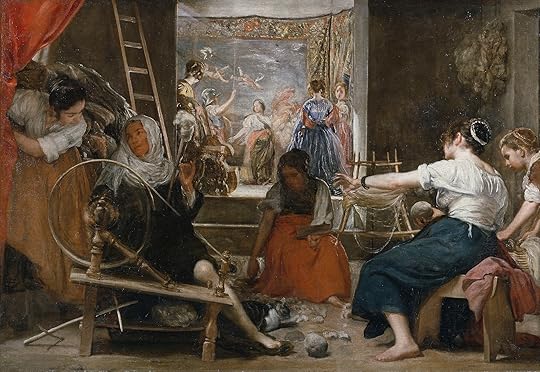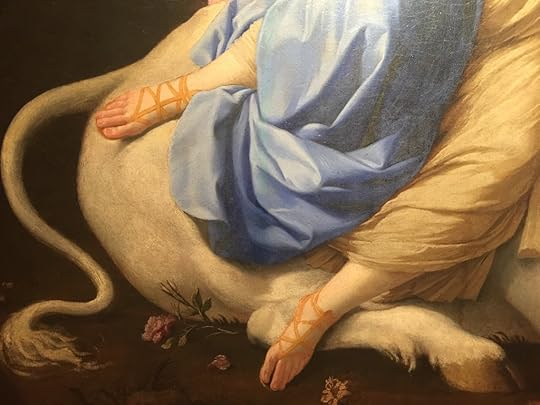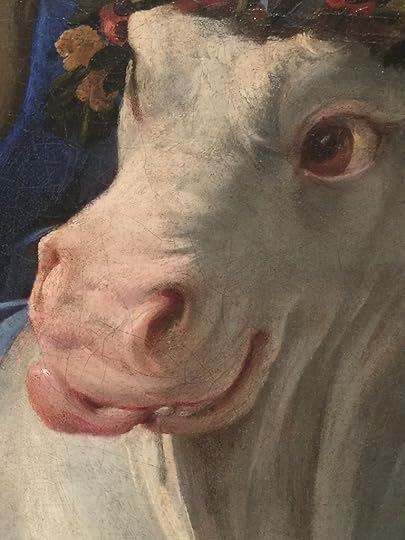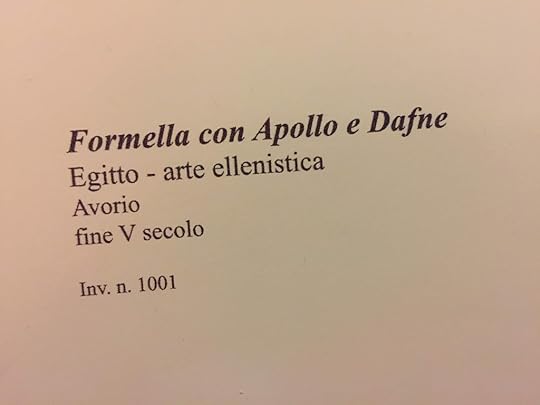 Kalliope’s
Comments
(group member since Aug 28, 2018)
Kalliope’s
Comments
(group member since Aug 28, 2018)
Kalliope’s
comments
from the Ovid's Metamorphoses and Further Metamorphoses group.
Showing 361-380 of 610
 Roman Clodia wrote: "I think it's that story-telling itself is one of the themes of this poem and Ovid keeps making us think about where stories begin or end, how one story becomes part of another, how stories replicate themselves. He's interested, too, in the relationships between storyteller and story
Roman Clodia wrote: "I think it's that story-telling itself is one of the themes of this poem and Ovid keeps making us think about where stories begin or end, how one story becomes part of another, how stories replicate themselves. He's interested, too, in the relationships between storyteller and story..."
I am seeing this work more and more under this light.
We are still at the beginning and for the moment I am just noting how he 'weaves' one story with the next. For the moment I am just noting down what I see as the link. The Simpson notes do mention various scholars who have debated on the various formulae but I am not paying too much attention as yet at these theoretical aspects. For the moment just trying not to lose 'the thread'.
 Roger wrote: "
Roger wrote: "Ha! I suppose I knew this once, but I had completely forgotten until you menti..."
What looks like a viola may not be so - the inwards curve is too exaggerated. I have read somewhere that it is an instrument used in weaving and textile manufacture. I will try to find this reference.
This is another instance of how difficult this painting is.
As for the theatrical appearance of two of the figures in the back - those representing Minerva/Athena and Arachne - it has been suggested but no in regards to opera but just theatre. This was the time of the Spanish Golden Age in drama.
In a Seminar conducted a couple of years ago by Javier Portus, (the current Head of the Spanish school until 1700 in the Prado), I raised this question. Apart of the figure of Arachne who is clearly reciting out a speech there is the peculiar Athena whose helmet is too big for her. They almost seem girls acting out under the gaze of three court women.
Anyway, Portús told me that there is a literary scholar, Aurora Egido the editor of La fiera, el rayo y la piedra, who has defended a direct relationship between the painting and Calderón's play. In his opinion, the painting is too open to be able to identify any particular play. I have the book but have not read it yet.
 Vit wrote: "An intrigue of The Story of Pyramus and Thisbe, especially in the end, reminds of that in Romeo and Juliet
Vit wrote: "An intrigue of The Story of Pyramus and Thisbe, especially in the end, reminds of that in Romeo and Juliet“Then in his breast his shining sword he drown’d,
And fell supine, extended on the ground...."
Absolutely.... but even before Shakespeare we have Luigi Da Porto and Matteo Bandello.. but RC would know about this much better than I.
 The second point - the possible relevance to Velázquez's painting The Fable of Arachne or The Spinners, is very tentative.
The second point - the possible relevance to Velázquez's painting The Fable of Arachne or The Spinners, is very tentative.This painting belongs really to the discussion in Book VI.
But it occurred to me that may be this Book IV also has relevance.
The painting is, to my understanding, the most complex by Velázquez (even more than his Las Meninas).
Until relatively recently it was known as "The Spinners" - the scene represented in the foreground. But research and the finding of an old inventory record made it apparent that the real subject is in the background of the painting where a mythological scene is represented. And to this we will come back to in Book VI - with links to Book II (The Europa and Jupiter theme).
The overall subject or theme is thought to be the relationship between nature and art. Like Ovid, Velázquez would be meditating about his own art, the telling stories, the nature of representation, and various realities created in theatre, etc...
Anyway, following the discovery of the inventory the interest in the painting shifted to the background mostly, leaving the foreground to an strictly artistic discussion (Velázquez's ability to represent a wheel in movement; the pose of the woman with a white shirt and seen from the back, identified as a quote from Michelangelo's Sixtine chapel...).
But it dawned on me that the spinning women in the foreground could be related to Minyas's daughters. Very tenuous and I will explore further.
As a warning, there is no consensus on this painting - there have been many interpretations. My own thoughts will clearly remain on the pure speculative.
What is also noteworthy about this work is that it was not produced for the crown, but for Pedro de Arce, an employee of the court. Velázquez therefore felt a great deal more free when he designed his composition. He was also by then a very mature artist and by this time painted little (died four years later).
Anyway, I will come back to this...
Here is the painting.
Velázquez. Fable of Arachne / The Spinners. 1656. Prado.

 Story telling and spinning wool and weaving is an idea very suggestively explored in this Book.
Story telling and spinning wool and weaving is an idea very suggestively explored in this Book.With the first mention of the spinning I immediately thought of how Ovid begins his poem:
................... may
the song I sing be seamless as its way
weaves from the world's begins to our day.
[Mandelbaum]
 Nora wrote: "Book IV is among my favorite ones. It is, first of all, because of language and its variations. Also, this Book has very interesting structure, I would say mosaic - spiral: stories within story, wi..."
Nora wrote: "Book IV is among my favorite ones. It is, first of all, because of language and its variations. Also, this Book has very interesting structure, I would say mosaic - spiral: stories within story, wi..."Nora, I have now read about a half of the chapter and even with what I have read I feel very much at the surface, but I can now begin to appreciate your excellent post.
The spirally structure would clearly appeal to me, the spirally kalliope... One of the aspects I have been tracing in my document/index/table is how the narrative is put together.
Several other aspects are striking me in this first visit - one is the theme of narration and weaving and spinning and the other, related to the first, is the possible links to a painting by Velázquez.
 Lyn wrote: "I've checked in Robert Graves' The Greek Myths Vol II pp 543-544, where the story of Jason and the Golden Fleece is told. Medea protected Jason from fire-breathing bulls with whom h..."
Lyn wrote: "I've checked in Robert Graves' The Greek Myths Vol II pp 543-544, where the story of Jason and the Golden Fleece is told. Medea protected Jason from fire-breathing bulls with whom h..."Yes, the same teeth from the same Serpent - not just any teeth.
Thank you, Lyn.
Definitely I want to revisit this.
 Roger wrote: "
Roger wrote: "That would be the end of the fifth century CE? I'm no expert in this period, but it seems..."
No, it is not 'awfully late', Roger, because it comes from Egypt. In the late Classical period the East and West developed differently.
 Lyn wrote: "The descriptions of Envy are riveting. Teeth black with rust; breast green with gall; tongue dripping venom; seeing success she pines away with sorrow. She both torments and is tormented at the sam..."
Lyn wrote: "The descriptions of Envy are riveting. Teeth black with rust; breast green with gall; tongue dripping venom; seeing success she pines away with sorrow. She both torments and is tormented at the sam..."I agree, Lyn.. the description of Envy is fabulous...
I think I already posted something on Envy.. I will look for it
Meanwhile I also found this - interesting because of the poor Fabritius we normally only know his Goldfinch.
Not quite what your are looking for, Lyn... for Fabritius has chosen a suspended moment before and after anything happens... Mercury is 'about to' turn Aglauros into stone.
Carel Fabritius. About 1645-47. Boston Fine Arts.

But the best depiction of Envy, although not in an Ovidian context, is Giotto's in the Scrovegni chapel.

 Roger wrote: " What is the origin and concentration of the Thyssen, as opposed to the Prado? Like the Wallace Collection t..."
Roger wrote: " What is the origin and concentration of the Thyssen, as opposed to the Prado? Like the Wallace Collection t..."There is no connection between the two museums other than being across the street from each other. The Thyssen was originally the private collection of the two Barons Thyssen-Bornemisza. It is an admirable collection given that it was begun quite late. The older Baron liked the 'Old School' and the younger one expanded the 'Modern School'. The collection was deposited in Madrid for a ten year period at the end of which the country purchased it in block.
It complements the Prado very nicely - the way both grew is so entirely different.
 Lyn wrote: "I'd also like to know more about the connection between the Dragon's teeth that Cadmus sowed, and those sown by Jason on his quest for the Golden Fleece...."
Lyn wrote: "I'd also like to know more about the connection between the Dragon's teeth that Cadmus sowed, and those sown by Jason on his quest for the Golden Fleece...."I had forgotten about the teeth in Jason's quest. Thank you, Lyn. May be RC knows...
I read The Golden Fleece years ago and I would not mind revisiting it.
 Lyn wrote: "Roman Clodia wrote: "I'm late to the party here... but yes, the 'catalogue' of hounds names in the Actaeon story is, surely, a humorous riff on the 'catalogue of ships' in the Iliad? And those othe..."
Lyn wrote: "Roman Clodia wrote: "I'm late to the party here... but yes, the 'catalogue' of hounds names in the Actaeon story is, surely, a humorous riff on the 'catalogue of ships' in the Iliad? And those othe..."When I was reading through the names of the dogs, I kept wondering which names would I pick for a dog of mine...
 I the Thyssen there is this other Europa. Clearly following the Veronese formula..
I the Thyssen there is this other Europa. Clearly following the Veronese formula.. The French Simon Vouet. Circa 1640.
I took the photos.



Haha... that gloating and smug Jupiter.. drooling...
 Roger wrote: "
Roger wrote: "Yes, I have even read quite a few novels in Spanish, but I am a bit rusty now. ..."
It has chapters with some developed themes and then each painting has its own text.
But I have not read it yet. Let me come back on this when I have read it. When it first came out I was not going to buy it but then glancing through it again, it convinced me..
I visited today the BNE (exhibition on their Leonardo codices - unfortunately closed today) and they had it in their shop.
 Ce Ce wrote: "
Ce Ce wrote: "In the days leading up to Christmas I composed my own table/index. The very act of organizing and writing served to organize my memory an..."
Oh, you are also working on your own table... Yes, it is such a complex book - with such an intricate way of relating the stories, and the themes, that one needs to do a bit of extra work that goes beyond the mere reading.
 Elena wrote: "
Elena wrote: "All of which reminds me to look into Barolsky's book, which I bought six..."
Elena, the book I posted on the Mythologies in the Prado goes along those lines - of course, restricted to just one museum and encompassing not just Ovid, but other textual sources too.
I am very much looking forward to reading it, but like the Barolsky, I think I will tackle it after the Met.
 Roger wrote: ".Too expensive, alas! R.
Roger wrote: ".Too expensive, alas! R. ..."
I checked it in Amazon US and yes, about double.
You could order it from the Amazon.es or from abebooks.com... cheaper there. Can you read Spanish?
 I have been watching/listening to the Oratorio Semele as produced for the Zurich Opera House in 2007. William Christie was the Director and Cecilia Bartoli sang the leading role.
I have been watching/listening to the Oratorio Semele as produced for the Zurich Opera House in 2007. William Christie was the Director and Cecilia Bartoli sang the leading role.As I had posted earlier, I watched in 2006, live, the NY City Opera perform this with an impersonation of the Kennedys which seemed to me very successful.
I have also enjoyed the Zurich version. I just wish I could compare it now with the other one.
For this summary I am relying on the booklet of the DVD as well as on The Grove Book of Operas
The Opera/Oratorio was first performed in the Convent Garden in February 1744. During the decade of the 40s the Italian opera was falling out of fashion in London and was gradually substituted by oratorios. The libretto is in English.
It may seem peculiar that this theme would be used for an Oratorio - which would have been produced in concert form, allowing greater freedom now to current staging in modern dress -, but according to the Grove, Handel had already approached the Oratorio form through classical drama and felt confident that the theme would be suitable for the form. However, part of the public was not entirely in agreement. Oratorios were mostly performed during Lent, and the work was not very successful at the time. It only ran through six productions in London, and in two different theatres.
As the story is more developed than in Ovid, where the episode seemed more an introduction to the origin of another of Cadmus's grandchildren, here is a summary of the plot. There are three Acts.
FIRST ACT.
It begins with the marriage of Semele to Athamas, in the presence of the King Cadmus and the rest of his family. Semele however does not seem too keen on this wedding - she clearly has someone else in her mind to whom she appeals (of course, Jupiter). To thicken the plot we have her sister Ino in love with her betrothed Athamas. What seemed good omens are suddenly interrupted by nasty Thunders. Everyone flees. Cadmus then announces that a huge eagle with purple wings and a golden beak and starry eyes (ie: Jupiter himself) has taken Semele away.
The act finishes with one of the most famous arias - Semele singing Endless pleasure.. in which Semele extolls how blissfully happy she is with her lover.
SECOND ACT
We meet Juno and her messenger Iris. The latter informs the goddess that Jupiter is living with Semele in total bliss in a palace in Mount Cithaeron. This is a rather funny scene that puts both Iris and Juno somewhat in ridicule. Juno, with a Britiths Airwys ticket in her hand decides to set off in search of Somnus (Aria: Hence, Iris, hence away)
Change of scene and we see Semele alone in her bed. Jupiter, in the guise of a man arrives and the somewhat anxious Semele asks him not to leave her (Aria: 'O sleep, why dost you leave me?'. The difference in their nature - divine and mortal - is reminded to the audience. Interesting that even before Juno gets directly involved Semele is already feeling antsy about being a mere mortal in his divine court. He then thinks of things to distract her (Aria: I must with speed amuse her). He also calls the sister Ino to keep Semele company.
A couple of beautiful pieces sung by the chorus. (Now Love that everlasting boy invites & Bless the glad earth with heav'nly lays)
THIRD ACT
Juno and Iris go to Somnus's cave. This 'slumber scene' is lovely scene in this performance, showing all these people sleeping on the floor, seen through a veil and under blue light. Sumnos, as is to be expected is sung by a baritone. Juno promises him Pasithea, the nymph he likes (she does not seem to figure in the MET). The two divinities sing Obey my will.
Semele is then shown alone and expressing her frustration. Juno arrives (disguised as Ino - wearing the same clothes Ino wore in the First scene). This is the famous scene in which Juno manipulates Semele with a mirror - in the NY production they showed instead of mirrors, huge covers of Time/Life magazine and the like propped up against the walls showing Marilyn as a DIVA (a true divinity in today's world). Bartoli sings gloriously the 'Myself I shall adore' (may be this could have been sung by Narcissus too !!!). Great ovation in Zurich. The Grove says that in this aria Handel has played with 'mirroring musical figures'. I would not have noticed. Juno easily convinces Semele to move towards her own destruction.
When Jupiter comes in, he is ready to comply to anything that Semele may ask him. Semele is clearly a woman frustrated in her ambition. (No, no, I'll take no less). Jupiter (like Apollo and Phaeton), has no way out and will have to comply knowing the destruction that is coming. Juno observes, delighted.
Semele, in a very different tone from her earlier singing now begins to regret her petition. Too late. Jupiter descends in cloud form (like with Io) and she perishes in a storm. A beautiful chorus remind everyone of the dangers of transgressing the (social?) order (any implicit criticism to Handel's contemporaries?). Then Ino says that she will now marry Athamas. Jupiter, here dressed as King and looking very self-satisfied, at the end narrates that a soul has risen, like a phoenix, from Semele's ashes - the triumphant Bacchus who will be 'more powerful than Love'.
The Chorus, therefore, drinks in great joy and merriment. But we see that Jupiter is already ogling a new beauty and that Juno has detected this..... the cycle is ready to begin again... Haha.
To sum up: a beautiful opera. I wish I'll have the opportunity to watch other productions.
 I was yesterday in the Prado gift shop and found they were selling this bag...
I was yesterday in the Prado gift shop and found they were selling this bag...
Then I saw they also had the print. They don't know who drew it.




